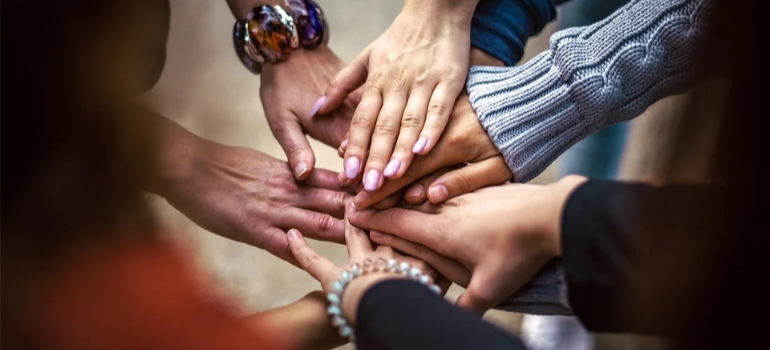We often hear of the sheer significance of community support in rehabilitation. In the same way, we recognize that peer pressure and influence can lead one to addiction; we understand that peer support can help liberate one from it. The value of community in rehab is widely accepted, especially among addiction treatment professionals. From group counseling and 12-step programs to other aftercare programs, we at Harmony Ridge Recovery have applied this principle ourselves.
But without proper definitions and applications, such concepts can often devolve into truisms. What exactly constitutes a community, and which community types best support recovery? Which longstanding recovery challenges does this principle ultimately address?
Today, let us explore these questions and more.
Persisting Challenges in the Recovery Process
First and foremost, any such explorations need to start with a fundamental question. The recovery process is infamously hard, from its first step to maintaining abstinence once rehab concludes. So which challenges persist and make up for this reality?
While every individual may encounter different challenges, as every journey to recovery differs, we largely identify 3 main challenges. Each of them corresponds to a recovery phase, and all 3 share the need for community support.
#1 Resistance to Seeking Treatment
The first challenge lies in taking that first step forward. People struggling with addiction will often not seek help for a plethora of reasons which can include:
- The inability to face their addiction and recognize its effects on their life
- Anxiety over the recovery process or inability to dedicate themselves to it
- Prohibiting rehab costs, alongside lacking health insurance coverage knowledge
In this regard, the value of community in rehab should be self-evident. An individual with strong peer support and encouragement may overcome these challenges and choose to combat their addiction. Whether through early interventions and discussion, psychological support, or financial support, respectively, a supporting community can make all the difference.

The truly sad reason why this cannot be overstated is its staggering scale. NCBI research finds “only about 1 in 10 people with a substance use disorder receive any type of specialty treatment”. Community involvement may not solve all such challenges this phase presents, by all means, but this number warrants herculean efforts.
#2 Lack of Continued Emotional Support
The second challenge lies in completing rehabilitation. Once an individual has taken the brave first step toward reclaiming their life, the true hardships of rehab unfold. If you have sought rehab for a loved one, as we have, you’re likely well aware of these hardships.
Rehab challenges span across the entire process, including:
- Powerful withdrawal symptoms and cravings during detox
- Co-occurring mental health disorders, i.e. dual diagnosis
- Maintaining abstinence in later stages without pharmacotherapy
To illustrate the true weight of such challenges, consider that AAC finds that “less than 42% of the individuals who enter treatment for drug and alcohol abuse complete it”. Here, too, the value of community in rehab can truly shine in the form of continued support.
Indeed, the active involvement of family members, partners, close friends, and broader communities consistently increases the chances of rehab completion. Individuals struggling with addiction often need solidarity, companionship, and guidance to heal emotionally and psychologically and carry on.
#3 Weak Post-rehab Support Networks
Finally, the third challenge lies in maintaining abstinence. If you’re in any way familiar with addiction treatment, you undoubtedly know of chronic relapse – and statistics agree it’s ever-present.

Echoing rehab completion rates, relapse rates for all kinds of addictions are also incredibly high. Studies disagree on exact numbers, but the most optimistic among them still present a staggering 40-60% relapse rate. Others, like those cited by DrugAbuse, paint an even bleaker picture:
“[More] than 85% of individuals relapse and return to drug use within the year following treatment. Researchers estimate that more than 2/3 of individuals in recovery relapse within weeks to months of beginning addiction treatment.”
Where the latter part can illustrate our previous point, the former can strengthen this one. Relapse rates are incredibly high across all addiction types and require robust support networks to address. In this regard, too, communities can cement aftercare programs and secure abstinence, as we’ll cover next.
Defining Communities
Now, before exploring the value of community in rehab further, we should first define communities themselves. In the context of addiction treatment, there are different communities and community practices worth discussing.
To do so, we should first define “peer support” as the goal such communities and practices should achieve. NCBI research helpfully does so in the following way:
“Peer support can be defined as the process of giving and receiving nonprofessional, nonclinical assistance from individuals with similar conditions or circumstances to achieve long-term recovery from psychiatric, alcohol, and/or other drug-related problems.”
With this definition in hand, we may then extract the 3 substantive examples of community-driven peer support the paper highlights.
#1 Immediate Community Reinforcement
First comes the Community Reinforcement Approach (CRA), which” is designed to make changes in the client’s daily environment”. It does begin with “basic guidelines for clinicians”, but it ultimately “offers a new treatment approach to all involved with the support and treatment of [addiction]”.
Understandably, as the name suggests, this practice goes far beyond treatment professionals and social workers. It includes co-workers and employers, neighbors and friends, teammates, and relatives. It includes communities in the colloquial sense of the word and requires their involvement to succeed.

If you would like more information on this practice, you may begin by exploring the CRA-adjacent Recovery to Practice (RTP) initiative. NAADAC’s “Including Family and Community in the Recovery Process” webinar does cater to professionals, but it still aptly highlights the value of community in rehab – and is still an invaluable resource for anyone wishing to be involved in the rehab process of their peers.
#2 12-step Programs
Finally, the sheer value of community in rehab may be found in 12-step programs. A fundamental asset toward relapse prevention and an invaluable tool for later stages of rehab, 12-step programs build communities in similar ways.

In case you’re unfamiliar, 12-step programs see use in an array of addictions, despite their origins in Alcoholics Anonymous (AA). The original AA steps have been adapted into 12-step-based programs, which can treat addictions to drugs and substances like:
- Ambien
- Barbiturates
- Benzodiazepine or “benzo”
- Cocaine
- Fentanyl
- Heroin
- Marijuana
- Stimulants
- Opiates and broader opioids
- Methamphetamine or “meth”
To achieve this purpose, 12-step-based programs see use across various rehab stages:
- Before rehab, as a self-diagnosis tool leveraging group dynamics
- During later rehab stages, as a form of group therapy that facilitates socialization
- In aftercare programs, as an effective form of abstinence maintenance and relapse prevention
In the context of aftercare specifically, these programs can also synergize with Alumni programs, and sponsor relations. In all cases, such programs effectively thrust the individual into a group setting where they can socialize and receive support. Over time, they enable the formation of communities among peers, ones with shared experiences, spaces, and goals. In this regard, too, the value of community in rehab cannot be overlooked.
Recovery Capital and Community
To illustrate this further, here we can introduce another term; “recovery capital”. This is a crucial term to help us substantiate the exact benefit of community bonds and support and a very notable term overall.
Faces & Voices of Recovery cites Robert Granfield and William Cloud, who defined recovery capital concisely as follows:
“[Recovery capital is] the volume of internal and external assets to initiate and sustain recovery from severe alcohol or other drug problems.”
In the context of holistic addiction therapy, this is fundamental. Recovery capital must stem from all aspects of one’s identity and being, which William White breaks down into four types:
- The personal; core material resources, such as housing and financial resources, and psychological resources, such as self-esteem and dedication to rehabilitation.
- The cultural; deeply held belief systems and forms of spirituality that can strengthen the personal while giving the individual a deep sense of belonging, both to a larger group and to divine or spiritual powers.
- Familial and social; the presence, quantity, and availability of meaningful relationships, supportive partners and communities, and recovery-minded social events and gatherings.
- The communal; the sum of community resources dedicated to recovery, support, and abstinence maintenance, ranging from social activism and policies to educational-based recovery support and mutual-aid meetings.
As you can see, the value of community in rehab is stressed and outlined clearly across all types. The communal type hinges entirely on community, as does the familial and social. The cultural one depends on a community context and draws from it, offering the individual a sense of belonging. Even the personal type is somewhat nurtured by the communal, in that self-esteem and resilience are fostered through it.

Pinpointing The Value Of Community In Rehab
As such, to reiterate and solidify these conclusions, here we may pinpoint the sheer significance of community in recovery. To do so, we may cite a relevant SAMHSA page, which can add our final bit of context.
SAMHSA identifies 4 “major dimensions of recovery”:
- Health, as one overcomes addiction and secures their well-being.
- Home, offering safe and stable conditions to facilitate recovery.
- Purpose, entailing personal growth and self-reliance, social engagement, and a sense of belonging.
- Community, as relations and support networks, returns a sense of normalcy and offers “support, friendship, love, and hope”.
Notably, these align quite well with the principles of recovery capital. They also match the explicit purpose of AA’s 12 Steps and of all the 12-step-based programs that see use in addiction treatment today.
Community Support Throughout Recovery
As such, we may finally pinpoint where the value of community truly lies across the entire process of recovery.
- Early interventions; an engaged community can identify addictions earlier, increasing the likelihood of successful treatment.
- Encouragement and assistance; where an individual can fear the recovery process or refuse to commit, collective acceptance and encouragement can start the healing.
- Continued emotional support; as the individual struggles to detox and rehabilitate, family therapy and communal engagement can bolster their recovery capital.
- Post-rehab support networks; once the individual completes rehab, it is strong communal bonds and peer support that best enhance aftercare programs and provide robust support networks.
- Sense of belonging; whether through continued group therapy and 12-step-based programs, it is communities that ultimately inspire a sense of belonging and let the individual thrive.
It is thus no exaggeration to say that the value of community in rehab can separate success from failure. Throughout the recovery process, communities play a pivotal, undeniable role in building recovery capital.
Conclusion
Community engagement and peer support are often implicitly understood as vital components of recovery. We assume and somewhat understand their probable value, but rarely do we truly delve into what makes it so.
Hopefully, this exploration of the subject helped illuminate exactly why community matters as much as it does. It’s evidently not a mere hunch or inclination to lean into our human affinity for socializing. Rather, the value of community in rehab can be attributed to specific, tangible elements across the journey to recovery.
At Harmony Ridge Recovery, we apply the essence of these findings thoroughly and are proud of its results. If you would like to know more about how we do so, or if you’re ready to seek help for yourself or a loved one, please contact us today. Our teams are available 24/7 and will gladly offer any assistance or reassurance you need.
References:
https://www.ncbi.nlm.nih.gov/books/NBK424859/
https://americanaddictioncenters.org/rehab-guide/success-rates-and-statistics
https://drugabuse.com/addiction/relapse/
https://www.ncbi.nlm.nih.gov/pmc/articles/PMC5047716/
https://psycnet.apa.org/record/2002-00760-000
https://www.naadac.org/including-family-and-community-in-the-recovery-process
https://www.ncbi.nlm.nih.gov/pmc/articles/PMC6086495/
https://www.aa.org/the-twelve-steps
https://facesandvoicesofrecovery.org/2019/10/08/recovery-capital-its-role-in-sustaining-recovery/



